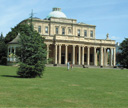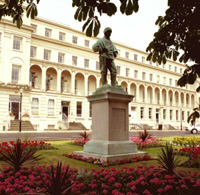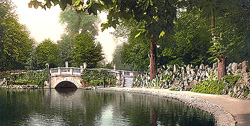THE VENUE

We’re getting married at PITTVILLE PUMP ROOM in the Spa Town of Cheltenham.
Visit the VENUE page for more information on this wonderful location.
TOURIST INFO
There’s an excellent website for visitors to Cheltenham, please take a look:
13 Facts About Cheltenham:
- Cheltenham was a market town as far back as 1226
- The Spa water at the Pump Room is the only natural alkaline water in Great Britain
- The church St Marys is the oldest building in Cheltenham, dating back to the 12th Century
- Prestbury (where we live in Cheltenham) is the most haunted village in the UK
- GCHQ – the governments spy, er sorry communications centre is based here
- Our theatre (the Everyman) was designed by Frank Matcham who also designed the London Palladium
- 14 Victoria Crosses have been won by former pupils of Cheltenham College. Only old boys of Eton (22 awards) and Harrow (15 awards) have won more
- The man largely responsible for bombing most of Germany in the Second World War “Bomber Harris” was born in Cheltenham in 1892
- Brian Jones, founding member of the Rolling Stones (died in a swimming pool) attended Cheltenham Grammar school and is buried in the cemetery in our village of Prestbury
- Other notable Cheltonians include: Gustav Holst (classical composer famous for The Planets), Richard O’Brien (the Rocky Horror Picture Show creator), Kate Thornton (X Factor Presenter), Eddie ‘The Eagle’ Edwards (Britains first ski jumper). The town can now boast a member of Cock Sparrer!!
- Jimi Hendrix and the Who amongst others played at the Blue Moon club.
- Frank Whittle assembled the first ever Jet Engine here.
- Amy and Daryl are getting married here!
Courtesy of the tourist board:
Regency Cheltenham
A town specifically designed for leisure and pleasure!
 Cheltenham became a spa town in 1716. According to legend the first medicinal waters were discovered when pigeons were noticed pecking at salty deposits which had formed around a spring. In 1788 King George III came to drink the medicinal waters, followed by other aristocratic and distinguished figures of the period - and Cheltenham's transformation into a fashionable resort began…
Cheltenham became a spa town in 1716. According to legend the first medicinal waters were discovered when pigeons were noticed pecking at salty deposits which had formed around a spring. In 1788 King George III came to drink the medicinal waters, followed by other aristocratic and distinguished figures of the period - and Cheltenham's transformation into a fashionable resort began…
Over the following decades the town developed in the architectural style famously popularised by the Prince Regent in Brighton, with sweeping classical terraces and elegant villas set in landscaped estates around broad tree-lined walks.
It was envisaged by one of its leading developers in 1824 as "the first English garden city with houses set among formal avenues and gardens"; that vision has fortunately been retained: Cheltenham is the most complete Regency town in England - a town specifically designed for leisure and pleasure.
Cheltenham's heyday as one of England's leading spas lasted from about 1790 to 1840 and it was this period that saw most of the architectural development that survives today. Much of the building was speculative, hence the various 'estates' (the foremost being Pittville, Montpellier and Lansdown) which grew around many of the early spa buildings. The signature surviving architectural setpiece of this period is undoubtedly the colonnaded and domed Pittville Pump Room.
 The Pump Room It is the only complete survivor of many - others having been demolished or found new uses (Lloyds Bank in Montpellier is little changed except, of course, in function!). But the Pump Room is where you can get a real sense of how it all began: a magnificently austere, Grecian-style edifice, surrounded by the imposing Italianate villas of the wealthy and overlooking the picturesque gardens and ornamental lakes of Pittville Park. The Pump Room was designed for balls and entertainments and, of course, the taking of medicinal waters. Today it is the setting for many such occasions, especially at Festival time, and visitors can still taste the waters - if they so wish!
The Pump Room It is the only complete survivor of many - others having been demolished or found new uses (Lloyds Bank in Montpellier is little changed except, of course, in function!). But the Pump Room is where you can get a real sense of how it all began: a magnificently austere, Grecian-style edifice, surrounded by the imposing Italianate villas of the wealthy and overlooking the picturesque gardens and ornamental lakes of Pittville Park. The Pump Room was designed for balls and entertainments and, of course, the taking of medicinal waters. Today it is the setting for many such occasions, especially at Festival time, and visitors can still taste the waters - if they so wish!
In the following decades Cheltenham continued to attract an eclectic mix of interesting building. Pre-eminent are the neo-Gothic school buildings of Cheltenham College with its 1896 chapel derived from that at King's College, Cambridge, and the Ladies' College built in the French-Gothic style with an unusual bronze dome.
The churches, apart from the medieval parish church of St Mary's, all date from this period of religious revival, reflecting not only the wealth of the town but also, in many cases, its connections with those followers of the Arts & Crafts Movement who set up their workshops in the surrounding Cotswold countryside:
 All Saints, for instance, is a treasure house of 19th and early 20th century craftsmanship, notably containing stained glass by Edward Burne-Jones, close friend and collaborator of William Morris, while St Gregorys pierces the skyline with its soaring spire - its size a testimony to Cheltenham's large catholic population resulting from the years when it was a popular refuge for French exiles of the Napoleonic Wars. William Morris (1834 - 1896) The name of the Montpellier area also recalls the town's connections with 19th century France and it is here that you will find the town's most enduring image: the caryatids - they decorate the 1820s shopping arcade which developed to serve the needs of visitors to the Montpellier spa.
All Saints, for instance, is a treasure house of 19th and early 20th century craftsmanship, notably containing stained glass by Edward Burne-Jones, close friend and collaborator of William Morris, while St Gregorys pierces the skyline with its soaring spire - its size a testimony to Cheltenham's large catholic population resulting from the years when it was a popular refuge for French exiles of the Napoleonic Wars. William Morris (1834 - 1896) The name of the Montpellier area also recalls the town's connections with 19th century France and it is here that you will find the town's most enduring image: the caryatids - they decorate the 1820s shopping arcade which developed to serve the needs of visitors to the Montpellier spa.
